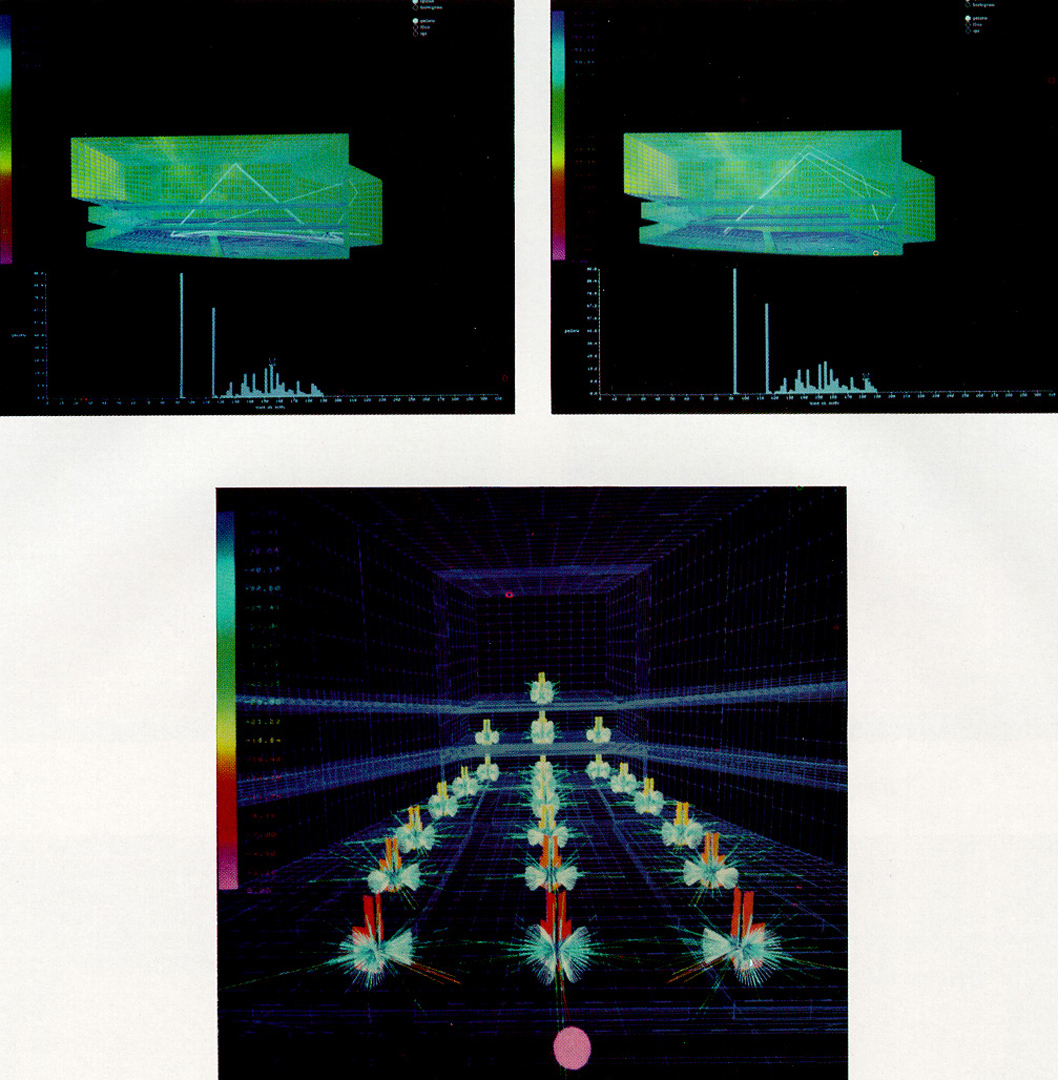“Computer graphics visualization for acoustic simulation” by Stettner and Greenberg
Conference:
Type(s):
Title:
- Computer graphics visualization for acoustic simulation
Presenter(s)/Author(s):
Abstract:
Computer simulations can be used to generate the spatial and temporal data describing the acoustical behavior of performance halls, but typically the analytical results are difficult to assimilate and compare. By using computer graphics to display the multi-dimensional data, substantially greater amounts of information than that conveyed by standard techniques can be communicated to the designer. This allows designs of different acoustical spaces to be tested, evaluated, and compared.An example comparing the acoustical behavior of three different concert halls demonstrates these techniques and allows for the simultaneous assimilation of much of the information necessary to evaluate the acoustical nature of a space. The use of three-dimensional images, color, animation and abstract representation allows for the comprehension of the complex results of a scientific simulation. Specifically, the simultaneous display of particular icons familiar to the discipline enabled the simultaneous presentation of up to twelve parameters.From a more general point of view, the procedures demonstrate how computer graphics can be utilized for the portrayal of multi-dimensional time dependent data. The visualization techniques are potentially useful for the display of three-dimensional vector fields in many scientific and design applications.
References:
1. Ailred and Newhouse, “Applications of the Monte Carlo Method to Architectural Acoustics,” Journal Acoustic Society America, Vol. 30, No. I0, Oct 1958, pages 903-904.
2. Barron M. and A. H. Marshall.”Spatial Impression Due to Early Lateral Reflections in Concert Halls: The Derivation of a Physical Measure,” Journal of Sound and Vibration, Vol. 77 No.2, 1981, pages 211-232.
3. Borish, J. “Extension of the Image Model to Arbitrary Polyhedra,” Journal Acoustic Society America, Vol. 75, No.6, June 1984, pages 1827-1836.
4. Bradley, J. S. “Experience With New Auditorium Acoustic Measurements,” Journal Acoustic Society America, Vol. 73, No.6, June 1983, pages 2051-2058.
5. Cremer, L. and H. A. Muller. Principles and Applications of Room Acoustics, Vol. 2, Applied Science, London, 1978.
6. Edwards, N. A. “Music Performance Acoustics and Room Shape: An Investigation Employing an Images Model of Room Acoustics,” Presented to the Acoustical Society of America Meeting, San Diego, Nov 1983.
7. Edwards, N. A. “Considering Concert Acoustics and the Shape of Rooms,” Architectural Record, Vol. 172, No.9, Aug 1984, pages 133 – 138.
8. Haviland, J. K. and B. D. Thanedar. “Monte Carlo Applications to Acoustical Field Solutions,” Journal Acoustic Society Ameiica, Vol. 54, No. 54, 1973.
9. Hedeen, Robert A., Compendium of Materials For Noise Control, US Dep. HEW, NIOSH Technical Report, Washington, D.C. May 1980.
10. Jordan, V. L. Acoustical Design of Conceit Halls and Theatres, Applied Science, London, 1980.
11. Keller, J.B. “Geomelrical Theory of Diffraction,” Journal Optitcal SocieO’ America, Vol. 52, No. 2,1962, pages 116- 130.
12. Kuttruff H. Room Acoustics, Wiley, New York, 1973
13. Krokstad, A. and S, Strom and S. SOrsdal. “Calculating the Acoustical Room Response by the use of a Ray Tracing Technique,” Journal Sound Vibration, Vol. 8 No. 1, 1968, pages 118-125.
14. London, “The Determination of Reverberant Sound Absorption Coefficients from Acoustical Impedance Measurements,” Journal Acoustic Society America, Vol. 22, 1950, pages 263-269.
15. Reichardt, W. and W. Schmidt. “Die Wahrnehmbarkeit der Ver~inderung yon Schallfeldparametern bei der Darbeitung yon Musik,” Acoustica ,Vol. 18, 1967.
16. Reichardt, W. and U. Lehman. “Optimierung yon Raumeindruck und durchsichtigkeit yon musikdarbietungen durch auswertung yon impulshalltests,” Acoustica ,Vol. 48, 1981~ pages 174-I85. o
17. Sabine, Wallace C. Collected Papers on Acoustics, Harvard University, Cambridge, MA 1927. Reprinted Dover 1964.
18. Sekiguchi, K. and Sho Kimura and Tomoyuki Sugiyama, “Approximation of Impulse Response Through Computer Simulation Based on Finite Sound Ray Integration,” Journal Acoustical Society Japan, Vol. 6, No. 2, 1985.
19. Schroeder, M. R. “Digital Simulation of Sound Transmission in Reverberant Spaces (Part 1),” Journal Acoustic Society America, Vol. 47, No. 2, 1970, pages 424- 431.
20. Stettner, A. S. Computer Graphics for Acoustic Simulation and Visualization, Master’s thesis, Program of Computer Graphics Lab, Cornell University, Ithaca, NY, January 1989.
21. Walsh, J. P. “The Design of Godot: a System for Computer-aided Room Acoustic Modeling and Simulation,” Proceedin~ l Oth International Congress on Acoustics, Sydney, 1980.
22. Wayman, J. L. and J. P. Vanyo. Computer Simulation of Sound Fields Using Ray Methods, PhD dissertation, University of California, Santa Barbara, July 1980.





